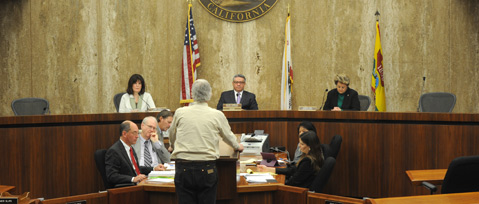County Talks Oil Tax
Proposed $1-Per-Barrel Fee Headed for June Ballot?

Although the Board of Supervisors’ divided decision Monday to move forward with its consideration of a $1-per-barrel tax on onshore oil producers didn’t officially place the item on next summer’s ballot, the direction of the conversation and the dynamic among the supervisors suggests the resolution could, indeed, be put before voters in June with implications far and wide.
If the proposal makes it to the ballot and is approved by 66 percent of voters, the revenue would fill county coffers to the tune of more than $3 million a year. And if the tax were enacted, it would make Santa Barbara County the first of California’s 58 counties to impose such a fee. It would even beat the state to the punch as a new statewide measure for the November election was proposed just this week. But the tax’s success or failure in the voting booths — as well as its effects on the months of campaigning leading up to the June election — will also loom large in area politics, with repercussions for an already-heated 2nd District race and an already-strained relationship between North and South County.
The 3-2 vote in favor of the tax split along north-south lines, with 4th and 5th District supervisors Peter Adam and Steve Lavagnino voicing their opposition early and then remaining largely silent for the remainder of the meeting. Adam, who called the county “famous for being business-unfriendly” and the proposed tax a “rush job,” worried about the tax’s effect on oil-industry employees. Lavagnino said that he didn’t like the idea of hurting one of his district’s two main job fields — oil and agriculture — and that he therefore didn’t want to go over the proposed tax’s details, as doing so would be akin to “choosing options on a new car you don’t want to buy in the first place.”
But the three South County supervisors chugged right along, deciding, among other things, how the ballot measure would be classified and where the tax’s revenues would be funneled. The tax would be a so-called special tax, meaning it would only require a 3-2 vote from the supervisors to make the ballot, a two-thirds vote from the public to become law, and it names the specific county departments — fire, parks, and libraries — that would receive the money. If approved, the tax would impose a $1-per-barrel fee on oil companies (with an indexed tax rate for possible inflation) but exclude wells that produce five or fewer barrels per day. According to a recent Grand Jury report on oil taxation — which recommended the supervisors’ approval of such a ballot measure — nearly 3.4 million barrels of oil were extracted in 2012.
“I think this is a positive step. My mantra would be: Let the voters decide,” said 2nd District Supervisor Janet Wolf on Monday. Wolf, whose seat is being challenged by Goleta City Councilmember Roger Aceves, further defended her position Tuesday morning. “In my mind, it’s a common-sense, commonly utilized business tax on an industry,” she said. “What wasn’t really said yesterday is that this is a local tax that stays here locally.”
Aceves, when asked what he thought of the board’s decision, said he would have preferred to see polling done to assess public opinion and called the two-thirds majority needed from voters “an uphill battle.” He also took issue with the measure’s likely timing, saying that the six months until June was a “short window” to educate the public about the measure.
For a discussion on energy, the public turnout for Monday’s meeting was fairly low with more speakers opposed to the tax than not. (Santa Maria Energy expressed its distaste for the tax in a statement released Tuesday.) Even Linda Krop, an attorney for the Environmental Defense Center, showed lukewarm feelings for the measure, expressing concerns that it could persuade county planning agencies to approve future drilling projects because of the expected tax revenues.
The county has considered such a tax before, most recently in February 2012; that discussion didn’t garner enough votes. The state, too, has examined the idea, even putting it before voters in 2006 with Proposition 87, which failed due largely to a $100-million opposition campaign waged by the oil industry. Although a few Los Angeles–area cities have imposed an extraction tax — but none as high as $1 per barrel — Santa Barbara County’s proposed measure would likely encounter just as much oil-industry resistance as Prop. 87, and the campaign, especially with its so-far ambivalent support from environmental groups, could turn into a David-versus-Goliath battle.
The proposed initiative may also address offshore-oil projects that are within three miles of shore, but the three supervisors said they needed more time to think about including such stipulations. The item will come back to the board on January 21, with a possible vote to place it on the ballot scheduled for February 4



